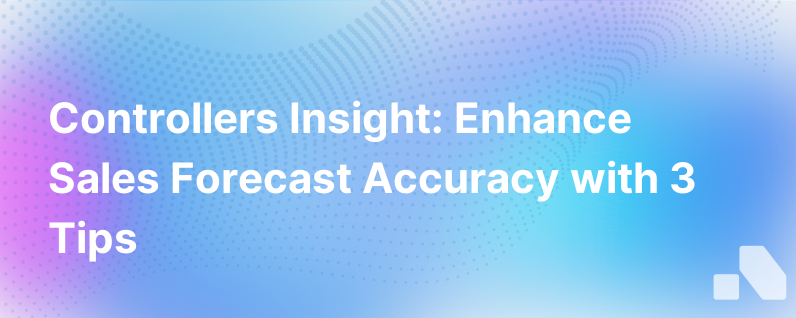
Sales forecasts serve as the nexus where finance and sales teams intersect, providing a glimpse into a company's fiscal fortitude. However, perfecting this business oracle is more alchemy than science, with numerous variables at play. A controller's insight is invaluable in enhancing the accuracy of sales forecasts, turning artful guesswork into data-driven precision. This crucial exercise impacts everything from cash flow management to strategic planning. Here, we outline three fundamental tips from a controller's stance to enhance the robustness and reliability of your sales forecasts.
Tip 1: Ensure Data Integrity
Start with Clean Data
The cornerstone of any accurate forecast is clean, reliable data. Sales input with duplicative, erroneous, or incomplete data will lead to skewed results that can mislead decision-making and growth projections. Controllers must advocate for robust CRM tools and processes that ensure data cleanliness. This necessitates standardizing data entry protocols, employing data validation strategies, and regularly auditing the database to correct or remove any inaccuracies.
Foster Sales and Finance Alignment
Misalignment between sales and finance often stems from a disconnect in data interpretation. Controllers are positioned uniquely to bridge this gap. By spearheading collaborative meetings, controllers can foster shared understanding and transparency in how data is recorded and reported. This mutual knowledge ensures that both departments work from a single source of truth and align their goals.
Audit and Validate Sales Pipelines
Validity checks on the current pipeline provide a reality check. Scrutinize the stages of your sales pipeline with the sales team. Flag deals that have remained stagnant for too long and investigate those with overly optimistic closing dates. Working closely with sales managers to regularly audit their pipelines for such issues can significantly enhance the accuracy of your sales forecasts.
Tip 2: Embrace Predictive Analytics and Scenario Planning
Implement Predictive Analytic Tools
The advent of machine learning and AI has bolstered the prediction-making process. Controllers can advocate for the adoption of predictive analytics tools that leverage historical data to forecast sales. This technology can identify trends, cycles, and patterns that the human eye might miss. Predictive models can also discern win probabilities, offering a more nuanced view than mere gut feelings or experiential guesswork.
Leverage Historical Data
Closely tied to predictive analytics is the trenchant analysis of historical data. Controllers ought to conduct a post-mortem analysis of prior forecasts, comparing them against actual results. This exercise helps to pinpoint sources of forecast variance, which can inform adjustments to prediction models and assumptions.
Incorporate Scenario Planning
One-off events and market anomalies can veer any sales forecast off course. Scenario planning prepares companies for such eventualities. Controllers should collaborate with the sales and executive teams to develop several 'what if' scenarios, each backed by assumptions that reflect different market or operational conditions. Running these simulations can highlight the resilience of your forecast model and pinpoint areas that may need additional planning or support.
Tip 3: Integrate Rolling Forecasts
Shift to a Rolling Forecast Model
Controllers are increasingly moving away from static annual forecasts to rolling forecasts that update continuously as new data becomes available. A rolling forecast system offers a real-time, perpetually updating view of the business landscape, which can lead to more precise and actionable insight.
Shorten Forecast Cycles
The agility of your sales forecast is partly dictated by the length of your forecast cycle. Controllers should aim for shorter cycles; monthly or quarterly forecasting can react more keenly to market shifts than a monolithic annual forecast. While this increases the forecasting workload, the benefit lies in agility and accuracy.
Encourage Regular Reassessments
Accuracy in sales forecasting is not just about the numbers but also about the frequency of reassessment. The quicker a company can respond to the divergence between forecasted and actual sales, the better it can manage resources and expectations. Controllers should advocate for regular forecast check-ins, tied in with rolling forecasts, to ensure continuous recalibration and alignment with business realities.
Conclusion: The Path to Accurate Forecasts
Navigating these three areas—data integrity, predictive analytics and scenario planning, and the integration of rolling forecasts—controllers can significantly improve the precision of sales forecasts. Clean data ensures that forecasts are based on factual, correct inputs. Predictive analytics and scenario planning prep the team for varying eventualities and nuanced insights, while rolling forecasts add the dynamism required in today's fast-paced business environment.
Fine-tuning sales forecasts takes diligence, collaboration, and a willingness to leverage advanced tools and methodologies. While perfection in forecasting remains a corporate mythos, the pursuit of a more holistic, data-centric approach is well within reach. For controllers, this pursuit means forging ahead with innovations, inspiring cross-department collaboration, and maintaining a relentless commitment to data veracity, which in turn transforms sales forecasting from an educated guess to a strategic asset.
Remember, Aomni may support these efforts by offering a complement to sales forecasting through actionable insights that further refine forecast accuracy, making the process more intelligent and outcome-focused.